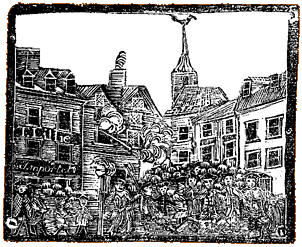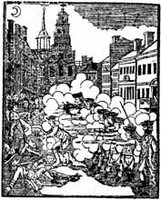Paying attention to black Loyalists
Sunday's Boston Globe featured an interview with historian Simon Schama on the occasion of his book Rough Crossings, about the experience of Loyalists of African ancestry before, during, and after the Revolution. It's interesting to compare the press this book is getting in the U.S. to what British reviewers had to say about it last fall. The North American media has focused on how it will rile American readers by supposedly breaking the news that most wealthy founders owned slaves and were upset at the prospect of losing them. In Britain, reviewers paid more attention to the book's latter half, which covers the Crown's broken promises to the black Loyalists in Canada and Sierra Leone. For instance, the Guardian's reviewer wrote
When the defeated British withdrew, thousands of former slaves found themselves herded on to British ships and relocated to Nova Scotia and London. Their miserable fate and protracted sufferings form the core of Schama's gripping new book.The book's Amazon.co.uk page shows how the original publisher played up the post-Revolutionary story for British readers. But of course Americans have short attention spans for Canadian history and Sierra Leone, so the U.S. publisher's copy emphasizes the Revolution.
Rough Crossings is one fruit of a huge (by historians' standards) book-TV deal Schama made a few years ago. The Wikipedia article about him states:
In 2003, Schama signed a lucrative new contract with the BBC and HarperCollins to produce three new books and two accompanying TV series. Worth £3 million (around $5.3m), it represents the biggest advance deal ever for a TV historian. The only confirmed project lined up as part of the deal is a book and TV show provisionally entitled Rough Crossings, dealing with stories of migration across the Atlantic Ocean and including chapters/episodes on Pocahontas, freed slaves, and the Irish famineApparently Schama found enough material on black Loyalists to build a series and book about them alone.
Such a large deal puts pressure on the publisher and author to produce large sales, and one route to that is to declare that the book tells a story that's never been told before. To his credit, in the Globe interview Schama demurs, saying his work adds "almost nothing" to the record, only public attention. And in fact it's easy to find other authors writing about black Loyalists today:
- This month in the New Yorker, Harvard professor Jill Lepore reviewed Schama's book alongside Cassandra Pybus’s Epic Journeys of Freedom: Runaway Slaves of the American Revolution and Their Global Quest for Liberty, and praised the latter for its new research findings from multiple continents.
- UCLA historian Gary B. Nash will speak at Old South Meeting-House on 15 June about his short new book, The Forgotten Fifth: African Americans in the Age of Revolution.
- Last fall Vincent Carretta has published his enlightening biography of the single most prominent black Loyalist, Equiano, the African. That publisher's page links to an interview with Carretta on his conclusions that Olaudah Equiano was not African-born, as he claimed.
- Last week Caleb McDaniel blogged about how the book that's said to have established the American tradition of ignoring black Loyalists in favor of African-American patriots, Boston author William C. Nell's Colored Patriots of the American Revolution, actually acknowledges black emigrés. McDaniel also provides a link to an online lecture by Cassandra Pybus, made available by WGBH.









